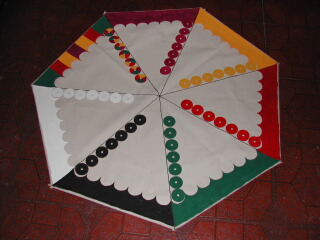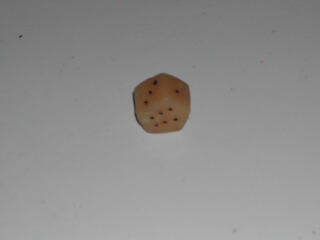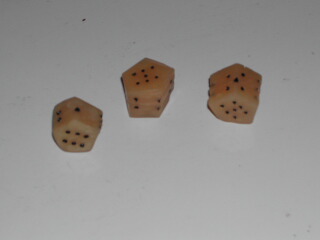
Date redacted: May 1, 2002. Discussion of seven-sided dice updated March 27, 2004.
Redactor: Justin du Coeur
Sources: The original source is the Libros de ajedrez,
dados y tablas, which was compiled for King Alfonso X in the 13th
century. This is generally known as the "Alfonso MS", and is available
online at
RenGeekCentral. Specifically, the text of this game is on page 97R, and the
picture of the board is on 97V. A
transcription is available on CD-ROM. This reconstruction is based
upon the translation by Roselyne
l'Estrangere, itself based upon the transcription.
There is now an alternate translation available, at the bottom of
Sonja Musser Golladay's translation of the Alfonso MS.
This reconstruction presumes that the game is generally similar to other tables games; that assumption is used to fill in the gaps in the brief description of the game. I believe that this reconstruction is likely to be correct, but as always may be superceded by better information.
The image of the board in the original source shows seven men sitting around what appears to be a large seven-sided game board. There are seven tablemen for each player, sitting on the Ace point (that player's left-hand space).
My constructed board looks a bit different from the original; this was intentional, to make it easier for players to remember what color they are playing. Note that, while the original picture doesn't show it, the description indicates that the sides should be painted like this. (It also says that each side should show the planet it corresponds to; I confess that I didn't bother.) The colors, in order, are black, green, red, yellow, purple, multicolor, and white.
My board is fabric, with a removeable dowel frame around the edges. It isn't clear what the original was made of: it appears to be on the floor, but it is hard to know whether it was made of wood, fabric, rug or something else. My board is roughly 18" on each side, which is large enough for seven players to sit around comfortably without being excessively large.

The dice were a more interesting problem. The original makes it appear that you are using seven-sided dice; the picture shows what appear to be two oblong dice showing 1 and 5, and a pentagonal one showing a 7. As far as I can tell, the intent is that the die is a pentagonal prism, with two pentagonal sides (on which I put the 6 and 7) and five oblong sides (for 1 through 5).
Of course, you can't buy seven-sided dice at the local game store. I chose to hand-scupt the dice out of Premo, a durable variant of Sculpy, available in most craft stores. I shaped the dice into roughly the right shape, then used a sharp clay knife to sharpen the edges. The resulting dice are not terribly even, and don't fall precisely equally. However, they work reasonably well, especially if everyone shares the same dice.
The first attempt to make the dice proved a failure. As soon as I made the first die, I realized that you can't just put the pips on the oblong sides, because a typical throw will show two oblong sides up, like this:

Obviously, this wasn't going to work. After a little thought, I concluded that you have to put the pips on the edges instead of the sides. This turned out to work reasonably well, and has the effect of making the dice appear oblong from the top, as in the original picture, so I suspect it is correct.

It should be noted, however, that we haven't yet translated the beginning of the chapter, which appears to concern dice-making, and which may shed more light on the subject.
Update: There is a new complete translation of the Alfonso MS. in progress by Sonja Musser Golladay, which sheds additional light on this subject. Buried the middle of Book Four (The Book of Large Games), we find this passage:
Because the shape of this die is uneven it falls edge up, with two sides showing. The side closest to the roller is his. If they fall so that it cannot be determined which face to use, they are to be thrown until it can.
It appears that this description is talking about seven-sided log dice rather than pentagonal prisms. However, it describes the pentagonal dice shortly thereafter, and says:
And for these five sides the play is the same as We described before.
So while it isn't completely conclusive, I am forced to suspect that my hypothesis above is incorrect: they really did put the pips on the sides of the dice, and dealt with the resulting ambiguity by choosing the side that was closest to the thrower. I don't like that solution as much, but it is probably more period. The only real supporting evidence for my design is the pictures, which do look more like my design; however, given the suspect perspective of period art, that must be considered a weak argument.
The remaining equipment required are seven tablemen for each player (I used a hole-boring drill to cut 2" disks from thin plywood), and a dice box to throw from. (It is not strictly clear that dice boxes were used during this period, but certainly were in later periods, so I choose to use them. Chessex makes a properly screwed dice box, albeit a rather expensive one.)
This game turns out to be a fast, slightly brutal version of tables. Bearing off isn't the point here; rather, the idea is to capture opposing men without being captured yourself.
Setup: To begin with, all players should place all seven of their men on their Ace point -- that is, their leftmost point on the board. Choose someone to go first; rolling for it works fine. I believe that the first player is at a very slight disadvantage (since the next player may be able to blot him immediately), but playtesting did not show this to be severe.
Movement: Each player, on his turn, rolls all three dice. He treats these three dice as three separate moves, each for a single man. You may move a single man two or even all three times (that is, you can use multiple dice for a single man), but each move must be individually legal. These are conventional rules for tables games, not addressed in the source. All movement is to the right; that is, counter-clockwise around the board.
There is one curious variation in the movement rules here. It appears that you should not count another player's Ace point, if it is still piled with more than one of his men -- you simply skip over that space. My best guess is that this is to speed the game up, by removing a bunch of spaces that can't be landed upon from consideration. (The original source is very unclear on this, but it's my best reconstruction so far. It also talks about not counting the space on which the men are initially placed; I think this is simply saying that you count the dice rolls exclusively rather than inclusively.)
We have been playing that, if a die roll simply cannot be used, it is skipped; in practice, we have found this to be rare. My assumption is that, if you can use a die roll, you must do so; you cannot voluntarily pass.
We have been playing that play then passes to the right (that is, counter-clockwise around the board), but the original is silent on this point.
Blotting: Conventional tables rules say that, if a space has more than one of your men on it, they are safe from capture. No opponent may land on that space so long as two or more of your men occupy it.
However, if only one of your men is on the space, it is vulnerable. If another player's man comes along and lands on that space, he captures your man.
Endgame: The game ends when only one player is left on the board. There does not appear to be any bearing off in this game. (Not many tablemen survive long enough to bear off, anyway.)
Scoring: The original makes it clear that this is a lightweight gambling game. Each player should have at least seven stakes, one for each of his tablemen. When an opponent takes one of your men, you pay him one stake.
Since our SCA branch doesn't (yet) have a common currency to gamble with, we have instead been scoring by keeping the men we capture -- that is, when you capture an opposing man, you hold onto it. The last player gets to take back his remaining men. The player(s) who wind up with the most men at the end are considered to have won. This scoring is essentially equivalent to the gambling rules, without actually involving money.
Overall, this proves to be a fun, fast, easy game. It takes only a few minutes to teach to novices, and doesn't appear to have any terribly deep strategies. A typical game takes perhaps half an hour, likely a little faster with more practice.
There are some considerable tactical issues, however. In particular, the defense/offense balance question common in tables games is especially sharp here -- whether to play conservatively and try to keep your men stacked and safe, or play aggressively and try to capture opponents. In practice, it appears that a balanced strategy is essential, keeping most men safe and sending out "scouts" to capture opponents.
The objective is to have the most men at the end, so getting better-than-even trades is the heart of the game. Making a man vulnerable by capturing an opponent is generally reasonable; doing so by capturing two opponents is always worthwhile. We found that the winner typically had around 10 - 11 men at the end.
Being last man standing is a definite advantage, since you get your men back; the remaining player usually wins, although that isn't necessarily the case. Note that going into endgame (only two players remaining) with three men left is a serious advantage, especially if your opponent has fewer than that: it allows you to leave two men stacked and safe, while using the third to fly around the board and harry the opponent.
The game is played as follows: